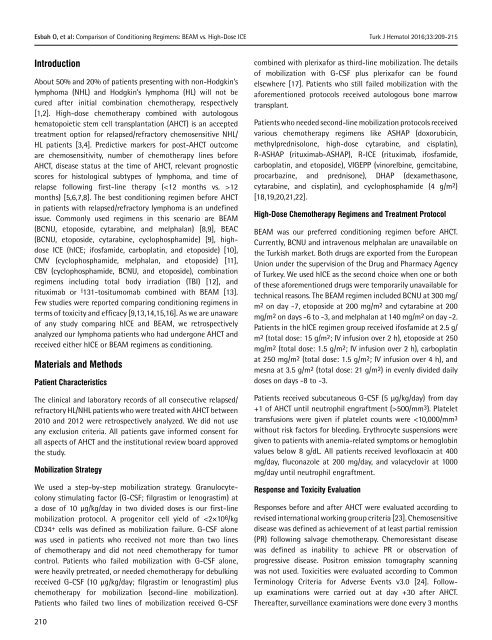Turkish Journal of Hematology Volume: 33 - Issue: 3
Create successful ePaper yourself
Turn your PDF publications into a flip-book with our unique Google optimized e-Paper software.
Esbah O, et al: Comparison <strong>of</strong> Conditioning Regimens: BEAM vs. High-Dose ICE Turk J Hematol 2016;<strong>33</strong>:209-215<br />
Introduction<br />
About 50% and 20% <strong>of</strong> patients presenting with non-Hodgkin’s<br />
lymphoma (NHL) and Hodgkin’s lymphoma (HL) will not be<br />
cured after initial combination chemotherapy, respectively<br />
[1,2]. High-dose chemotherapy combined with autologous<br />
hematopoietic stem cell transplantation (AHCT) is an accepted<br />
treatment option for relapsed/refractory chemosensitive NHL/<br />
HL patients [3,4]. Predictive markers for post-AHCT outcome<br />
are chemosensitivity, number <strong>of</strong> chemotherapy lines before<br />
AHCT, disease status at the time <strong>of</strong> AHCT, relevant prognostic<br />
scores for histological subtypes <strong>of</strong> lymphoma, and time <strong>of</strong><br />
relapse following first-line therapy (12<br />
months) [5,6,7,8]. The best conditioning regimen before AHCT<br />
in patients with relapsed/refractory lymphoma is an undefined<br />
issue. Commonly used regimens in this scenario are BEAM<br />
(BCNU, etoposide, cytarabine, and melphalan) [8,9], BEAC<br />
(BCNU, etoposide, cytarabine, cyclophosphamide) [9], highdose<br />
ICE (hICE; ifosfamide, carboplatin, and etoposide) [10],<br />
CMV (cyclophosphamide, melphalan, and etoposide) [11],<br />
CBV (cyclophosphamide, BCNU, and etoposide), combination<br />
regimens including total body irradiation (TBI) [12], and<br />
rituximab or I 131-tositumomab combined with BEAM [13].<br />
Few studies were reported comparing conditioning regimens in<br />
terms <strong>of</strong> toxicity and efficacy [9,13,14,15,16]. As we are unaware<br />
<strong>of</strong> any study comparing hICE and BEAM, we retrospectively<br />
analyzed our lymphoma patients who had undergone AHCT and<br />
received either hICE or BEAM regimens as conditioning.<br />
Materials and Methods<br />
Patient Characteristics<br />
The clinical and laboratory records <strong>of</strong> all consecutive relapsed/<br />
refractory HL/NHL patients who were treated with AHCT between<br />
2010 and 2012 were retrospectively analyzed. We did not use<br />
any exclusion criteria. All patients gave informed consent for<br />
all aspects <strong>of</strong> AHCT and the institutional review board approved<br />
the study.<br />
Mobilization Strategy<br />
We used a step-by-step mobilization strategy. Granulocytecolony<br />
stimulating factor (G-CSF; filgrastim or lenograstim) at<br />
a dose <strong>of</strong> 10 µg/kg/day in two divided doses is our first-line<br />
mobilization protocol. A progenitor cell yield <strong>of</strong> 500/mm3). Platelet<br />
transfusions were given if platelet counts were

















